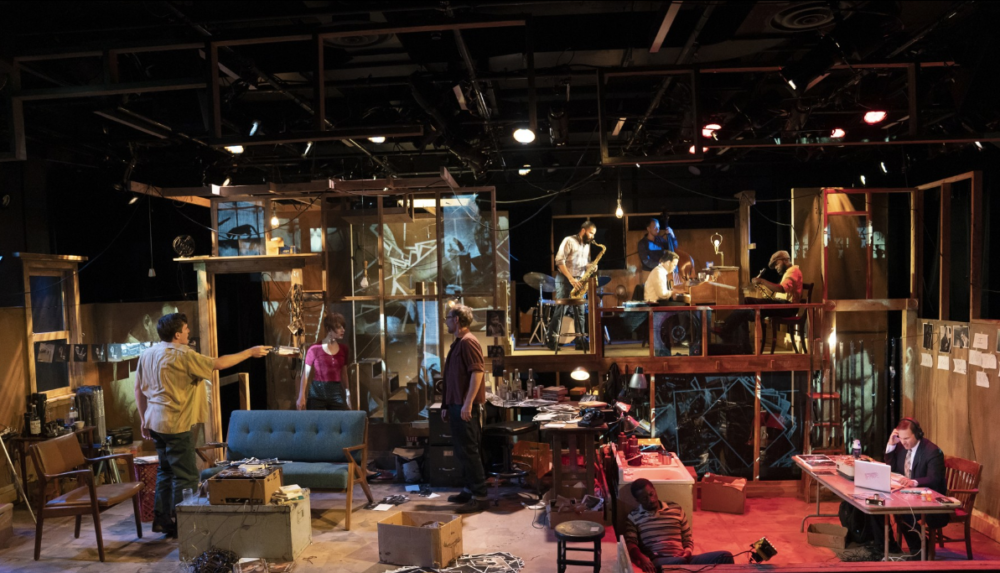(A)loft Modulation
Jazz is a famously unstructured form of music. Often improvised, and unpredictable, it doesn’t matter if there is no clear ending to the song: the mere experience of listening is thrilling enough.
(A)loft Modulation, the new play by Jaymes Jorsling that chronicles years spent in a dilapidated loft that was home to artists, draws upon jazz for its inspiration and presentation. A live band led by saxophonist Jonathan Beshay improvises throughout the performance, but despite jazz featuring prominently in the story and the show, Jorsling’s script does not inspire the same excitement as the music form. Unstructured and unfocused, yes, but thrilling, no.
Directed by Christopher McElroen and performed at A.R.T./New York Theatres, (A)loft Modulation was inspired by events taking place at a loft apartment in the 1950s. Located at the corner of 28th Street and Sixth Avenue where photographer W. Eugene Smith lived following his departure from both “Life” magazine and his family, the loft was a hub for artists and drugs and host to guests like Salvador Dali while Charles Mingus, Bill Evans, and Sonny Rollins. These events were obsessively recorded by Smith, who, along with taking more than 40,000 photographs of the loft, recorded more than 4,500 hours of audio after wiring the entire building.
In Jorsling’s play, Smith is named Myth, and his artifacts have been discovered by Steve Samuels, a fictional modern-day counterpart to the obsessive artist, who preserved the photographs and recordings in a radio series, book and exhibit titled “The Jazz Loft Project.” The play depicts him listening and looking through the memories as they are simultaneously enacted opposite him.
These Cliff’s Notes should not be necessary to enjoy or appreciate (A)loft Modulation, but they are. Without the knowledge that these events actually took place or even that Samuels’ work paid off, what the 2 ½ hour show presents is a series of drug and alcohol-addled men talking while ignoring, dismissing or abusing the few women with whom they interact. Their narcissistic tunnel vision is occasionally interrupted with glimpses of the world outside (rapidly changing, including the Cuban Missile Crisis), courtesy of a local policeman commenting on Myth’s self-destruction while discussing the public’s reactions to Myth’s work (unfavorable).
The presentation is impressive, with a grimy, atmospheric set by Troy Hourie, dimly lit by Becky Heisler McCarthy. The jazz band, featuring musicians Beshay along with, Kayvon Gordon (drums), Adam Olszewski (bass) and Eric T. Miller (piano), greatly enhances the at times sluggish pace of the show with a vital burst of inspiration. And the cast, including PJ Sosko as Myth, Way Tonniver and Charles Hudson III and Elisha Lawson as Reggie Sweets,is impressively devoted. But these men are overwrought and underwritten, frequently giving lengthy monologues about art, drugs and sex. While the men agonize and rejoice about the discoveries of art and history, thewomen are given little to say on the subjects.
Little that’s better can be said of the female characters, who are nothing more than thinly-written stereotypes, despite the efforts of the talented actresses playing them. Christina Toth’s Skyler, a prostitute with an undefined attraction to Myth, could have been a compelling representation of a changing world for women, but that opportunity was left untouched. As Steve’s wife, Julia Watt convincingly portrays her frustration with her husband’s increasing neglect, but is given little else to do. The duo’s marriage is another missed opportunity for more developed relationships. A passing reference is made to fertility struggles as an excuse for Stephen’s growing obsession with the loft, offering a chance for a more intimate look at their life together, but it is never discussed again.
None of the characters convincingly embody the conflict necessary to drive a 2 ½ hour production. These people are before us, but we don’t know why we’re watching them. Struggling professionally and suffering from an unspecified illness, Samuels has the most opportunity but the script does not develop any of the aforementioned issues, instead telling but not showing that he quit his job and is rapidly descending into financial ruin in pursuit of this project before the play frantically skips from one scene to the next. These scattered scenes never unite to form a cohesive drama that warrants the audience’s investment.
In the midst of one confrontation between Stephen and his wife, she asks, “What is your endgame?” As he wrote (A)loft Modulation, Jorsling would have done well to ask himself the same question.


